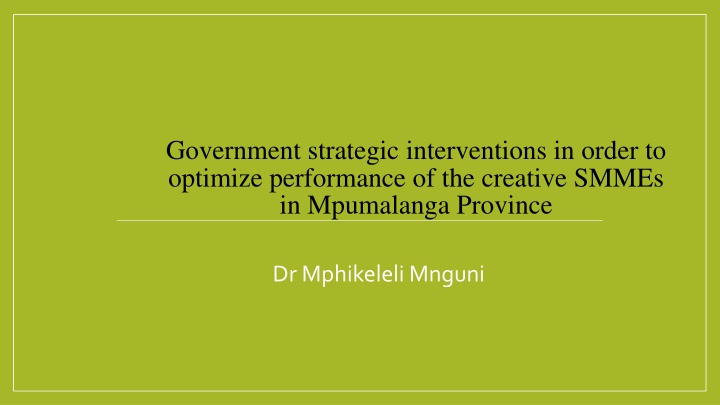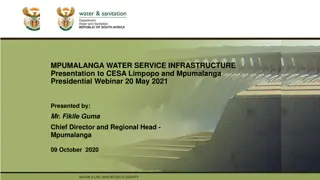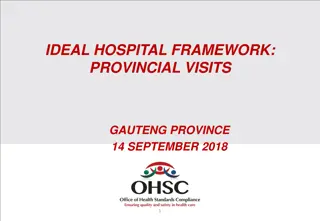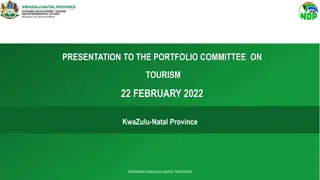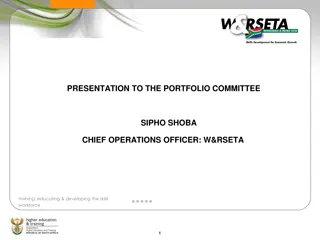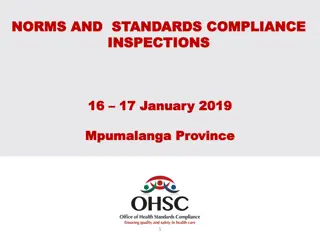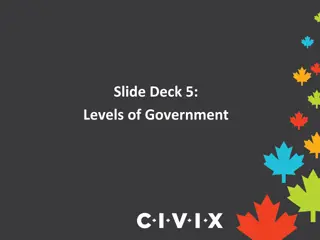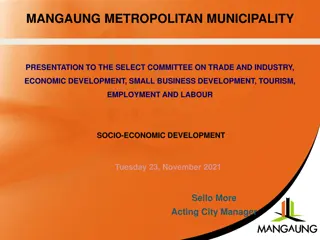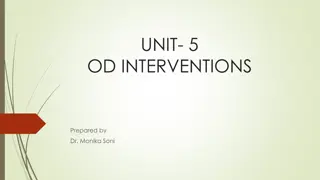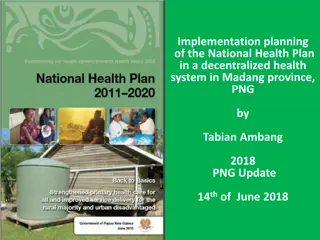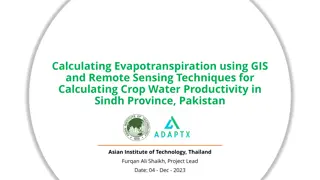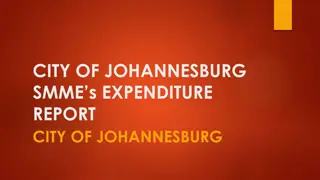Optimizing Performance of Creative SMMEs in Mpumalanga Province Through Government Strategic Interventions
Significance of Cultural and Creative Industries in Mpumalanga province is explored in this study, highlighting challenges faced by creative SMMEs and the need for government interventions. Professionalization of service delivery, service quality models, and service leadership are discussed as key components to enhance the performance of creative enterprises.
Download Presentation

Please find below an Image/Link to download the presentation.
The content on the website is provided AS IS for your information and personal use only. It may not be sold, licensed, or shared on other websites without obtaining consent from the author.If you encounter any issues during the download, it is possible that the publisher has removed the file from their server.
You are allowed to download the files provided on this website for personal or commercial use, subject to the condition that they are used lawfully. All files are the property of their respective owners.
The content on the website is provided AS IS for your information and personal use only. It may not be sold, licensed, or shared on other websites without obtaining consent from the author.
E N D
Presentation Transcript
Government strategic interventions in order to optimize performance of the creative SMMEs in Mpumalanga Province Dr Mphikeleli Mnguni
Introduction The significance of the Cultural and Creative Industries (CCIs) not only in the intrinsic values, but also in the instrumental values, is elucidated in social science studies. Instrumentally, at least 6 mapping studies in SA were conducted to measure the size, structure and impact of CCIs in relation to GVA/GDP, employment and trade. These studies serve as background justification for governments support. However, the creative sector finds it difficult to perform as expected, with regard to inclusive economic growth and job creation. The constraints that affect the performance of these enterprises constitute the problem statement for this study This study sampled the creative SMMEs in Mpumalanga to explore if their performance can be explained - from the artists perspectives - by the lack of support or service offered by the Department of Culture, Sports & Recreation
Professionalization of service delivery 1. Service leadership The concept of service leadership is key to success Key attributes of the service leader: Service vision which views service quality as a force for customer satisfaction, business success and profit maximization When crafting strategies for improvement, the service leader sees quality as the winning strategy Service leader must develop a passion for service quality within the workforce High standards big goals and put extra pressure on themselves to achieve them in the timeframe they have set In-the-field leadership style The field is where actions take place
Professionalization of service delivery cont 2. Service delivery frameworks Public Service Act 30 of 1994 as amended Public Service regulations of 2016 as amended Public Service Operations Management Framework, 2015 (tools) Service Delivery Model (SDM) b. Service Operating Procedure (SOP) Service Delivery Improvement Plan (SDIP) a. c. to improve the quality of life by maintaining healthy minds and bodies though active participation in arts and culture .and ensure effective investment in resources and systems for the delivery of quality service
Service quality models Service Quality has proved to be a controversial concept to grasp Referred to as elusive construct, it is difficult to define and measure and its research is still unresolved and far from conclusive (Brady & Cronin, 2001). Although authors agree on the multi-dimensionality or multi-attribute of SQ, but not on the nature of its measurement In 1980s service quality authors developed perceived service quality models. European or Nordic - (1982 - 1984): Dimensions - Technical or physical (What?) Outcome Functional or interactive (How?) Process) Image or corporate quality refers to image, as a filter, attributed to service provider 1. a. b. c. American - Functionality (1985 - 1988): Dimensions - Reliability, Responsiveness, Empathy, Assurance and Tangibility 2.
qq Technical model - 1984 Perceived service quality Expected service Perceived service Functional quality - How? Technical quality - What?
Service quality dimensions Reliability: The ability to offer promised services dependably and accurately. 1. 2. Responsiveness: The willingness to help customers and provide prompt service Assurance: The knowledge, courtesy, politeness and competence of officials to perform service as well as their ability to convey trust and confidence 3. Empathy: The provision of caring, sensitivity and individualised attention to customers/beneficiaries/clients 4. Tangible: The appearance of physical facilities, equipment and communication materials 5.
SERVPERF Cronin and Tailor (1992) argue that SERVQUAL is cumbersome and not psychometrically sound (44 scales) They proposed a psychometrically sound performance-based measure of SQ that measures the cause- effect relationships between SERVICE QUALITY > CONSUMER SATISFACTION > PURCHASE INTENTIONS This causal order model helps managers to measure SQ and determine what attributes of service delivery best define its quality
SERVPERF Model Quality service Dimensions Tangibility Reliability Responsiveness Assurance Empathy Perceived Purchase Customer Service satisfaction intentions quality
Hierarchical model The model proposes that SQ consists of Technical and Functional dimensions with an organization s service Image functions as a filter in the perception of service quality Although there is a theoretical support for a multi-dimensional model of service quality, little effort has been taken to conceptualize and empirically test such a structure.
Hypothesis testing Tan Tangibility H1 Rel H2 Performance of Artists satisfaction H6 Res H3 SMMEs H4 Ass H5 Emp
Sample size from the three districts District Populati on Sample Size Questionnaire Distribution Expected Min Return Rate Response Ehlanzeni (5) 403 184 221 115 143 Nkangala (7) 247 112 135 70 97 Gert Sibande (5) 226 104 124 65 71 Total 876 400 480 250 311
Reliability and validity Before data analysis, the reliability and validity of the items used in the study were tested. For instance, in order to have a valid construct, its items must be uni- dimensional i.e. measure only one construct
Coefficient Reliability Cronbach s Alpha was used to test the internal consistence of items and the acceptance value = or > 0.7 Tangibility = 0.88 Reliability = 0.87 Responsiveness = 0.90 Assurance = 0.88 Empathy= 0.84 Satisfaction = 0.78 Performance: 0.79
Validity Convergent validity Average Variance Extracted (AVE) = or > 0.50 Composite Reliability (CR) = or > 0.70 Discriminant Validity Inter-construct correlation matrix used to test the correlation amongst constructs was < 1
Structural Equation Model SEM, together with the SPSS Amos, a computer programme was used to investigate the underlying relationships of (1) service quality, (2)satisfaction and (3) performance ,with (4) satisfaction being the mediating factor. SEM as a multivariate statistical technique, comprising the estimation of parameters for a system of simultaneous equations. It employs, inter alia, factor analysis, confirmatory factor analysis, regression analysis and path analysis or structural modelling.
Findings: Creative turnover What is the turnover of your organisation annually? Frequency Valid Percent Turnover R0 - R150,000 305 98.1% R150,001-R400,000 5 1.6% R2,000,001- above 1 0.3% Total 311 100%
Employment SMME Employment Frequency Valid Percent Have you employed people? Yes 89 28.6% No 222 71.4% Total 311 100%
Findings vs Schedule 1 In terms of the revised schedule 1 (2019), small enterprises are defined along two proxies Sector (SIC) Size or class Full-time equivalent of paid employees 51 - 250 11 -50 Total annual turnover R40m R15m Medium Small Micro 0 - 10 R5m The study shows that: 100% have income of R2,000,000 222 (71%) do not create jobs and 29% create jobs This means that CCIs are overpopulated by informal and micro enterprises
Findings: Correlations Path coefficient Hypothesis Estimate Loading Results (P-value) *** ( ) 0.280 1. TAN SAT H1 Positive and significant 2. REL SAT H2 -0.086 0.126 Negative and insignificant 3. RES SAT H3 0.035 0.526 Positive and insignificant 4. ASS SAT H4 0.134 0.024 Positive and significant 5. EMP SAT H5 -0.150 0.006 Negative and significant 6. SAT PER H6 0.958 *** Positive and significant
Qualitative study findings 3 Focus groups Tan: The groups lament about the absence of cultural infrastructure and invisibility of management to support artists in rural areas Inability of management to provide service trustworthy and accurately Reluctance and unwillingness of management to provide service in Mpumalanga Management lacks knowledge and curtesy to convey trust and confidence to artists Emp: Management does not give care and attention to artists plight Rel: Res: Ass: To sum up: this, together with oblivion, inculcates hopelessness, despondency, lack of confidence in government and trust deficit
Recommendations How to address effectiveness of excellent service delivery (quality service)? 1. Concept of Service leadership is key to success Attributes of the service leader: Service vision quality service as a winning strategy of organisational culture Better equipped with hight standards and also focus on details In-the-field leadership style 2. Measurement of the effects quality service to artis satisfactions, using its attributes: Tangibility, Responsiveness and Assurance (Reliability and Empathy?). These approach will lead to the greatest improvements because it informs government not only which services must be offered, but also how to render service to the sector. 3. 4.
